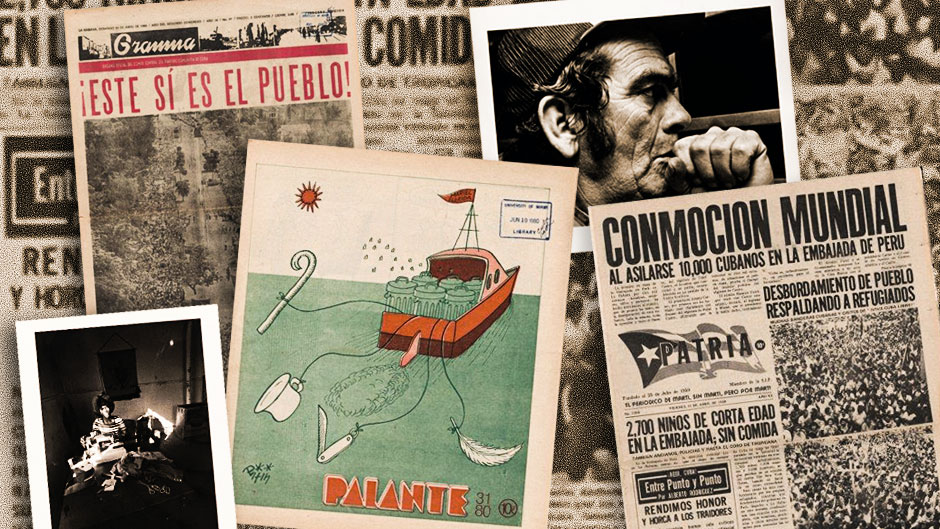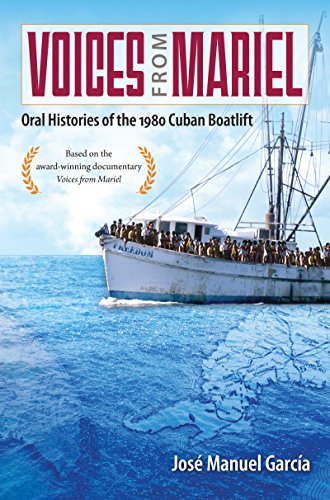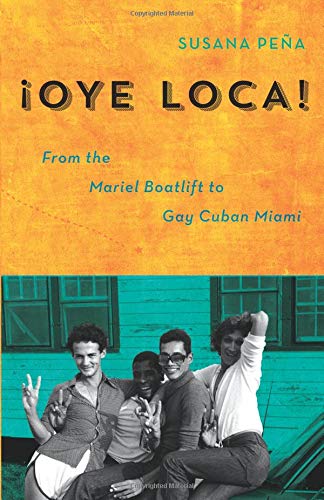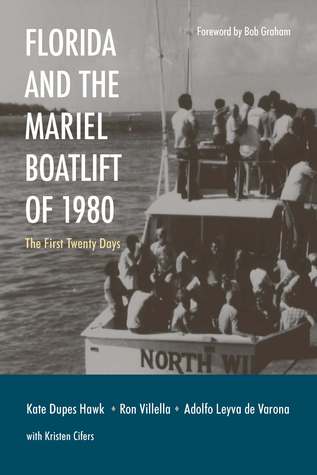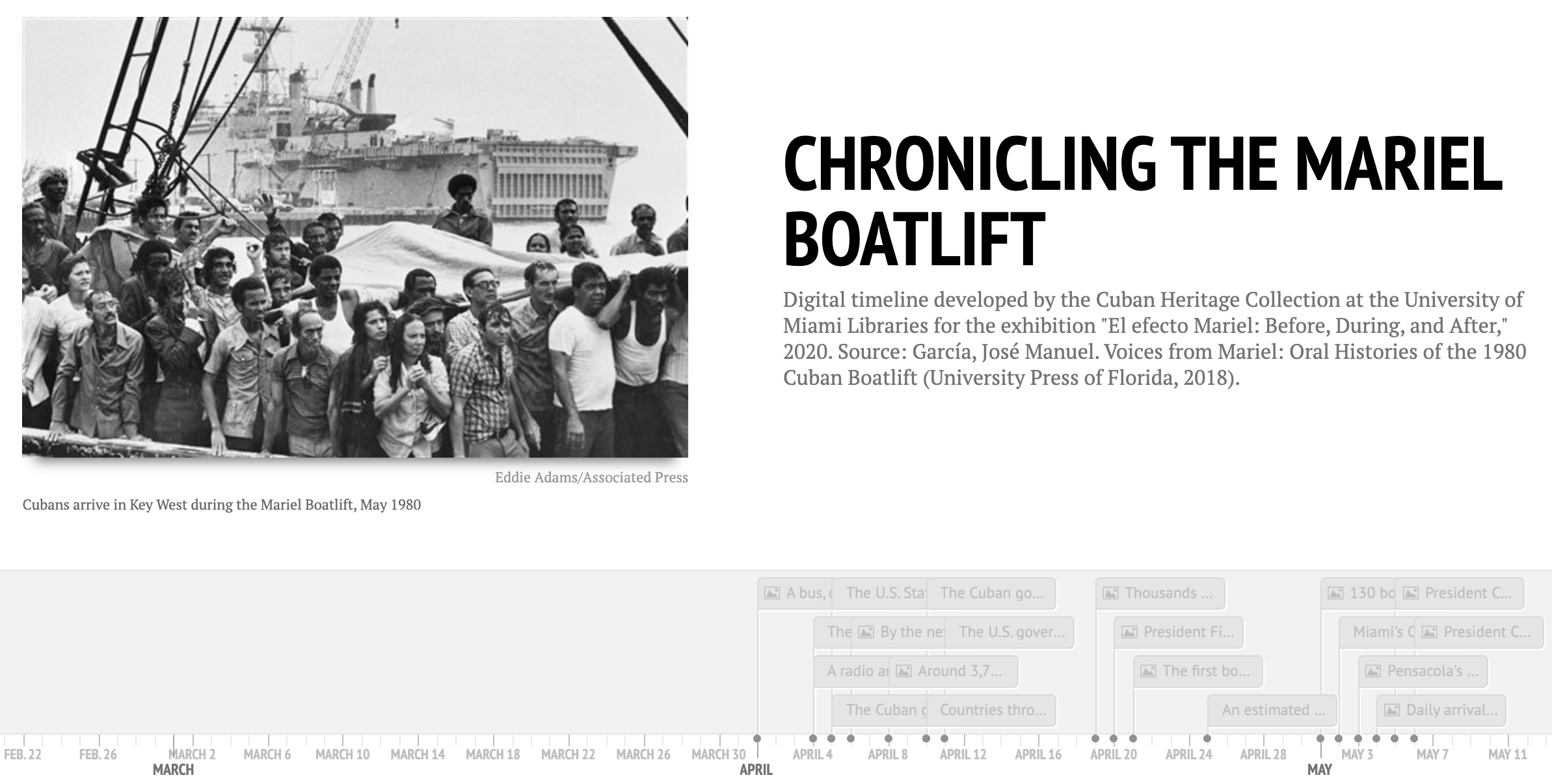Accessibility Options:

Table of Contents
CHC on Social Media
Introduction to Researching Mariel
The rapidly escalating situation forced the Cuban government to enter into negotiations with the Peruvian government, as well as with President Carter’s administration who had already declared that the US would grant asylum to those seeking to leave the country. These dramatic events that unfolded in the spring of 1980 transformed into what would become known as the Mariel Boatlift --- the massive movement of over 125,000 Cubans from the port of Mariel to the shores of South Florida.
This arrival of Cubans to the coasts of South Florida in the span of a few months had a long-lasting impact at local, national, and international levels, each of equal paradigmatic-shifting proportions. Among many other facets, research on Mariel spans both primary and secondary sources and explores the social and racial tensions that emerged following the boatlift in South Florida; gender, sexuality and the HIV/AIDS crisis; the Cuban exile community’s response to this new influx of Cuban refugees; politics; Mariel’s impact on immigration policies; media coverage; and the significant impact of the Mariel generation in Cuban diasporic cultural production.
This guide provides resources available at the Cuban Heritage Collection and materials held at other institutions for investigating Mariel from a variety of angles and through multiple approaches and disciplines. We have provided links to digital content where applicable, including open access collections. Some online material such as newspaper databases and streaming media may only be available to UM students, faculty, and employees.
UM News@TheU article: Explore the Cuban Heritage Collection’s Mariel boatlift materials
Subject Specialist
-

-
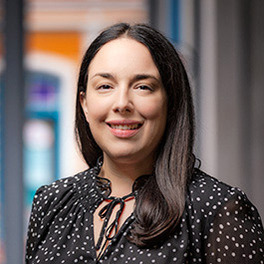
Amanda Moreno
Esperanza Bravo de Varona Chair and Director of the Cuban Heritage Collection
-
-
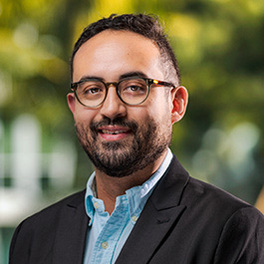
Juan A. Villanueva
Cuban Heritage & Spanish Language Collections Archivist
305-284-4008
Streaming Mariel Film Resources
Please note some of the films listed here are solely about the Mariel Boatlift. Others mention it in some part of the transcript; often they are recounting one migrant’s story.
The list is sorted by databases available through subscription by the University of Miami Libraries as well as by open access content that can be viewed by anyone. You will need a valid UM CANES card to access AVON and Films on Demand content.
AVON – Academic Video Online
Belton, David; Fritz, Sonia. Peril and Promise. PBS, 2013
Burroughs, Jim. Cuba: In the Shadow of Doubt. Filmmaker's Library, 1987.
Giroux, Yan. Cubanos, Life and Death of a Revolution. Documentary Education Resources, 2007.
Jennings, Tom. The Fidel Castro Tapes. PBS, 2014.
Moy, Holly. Escape from Cuba, PBS, 2018.
Sanders, Peter. Altina. First Run Features, 2014.
Singer, Marc. Dark Days: Fragile Dwelling. Oscilloscope Pictures, 2000.
Films on Demand
In the 1980s, the nature of the Latino Diaspora changes again. From Cuba a second wave of refugees to United States – the Mariel exodus – floods Miami. The same decade sees the sudden arrival of hundreds of thousands of Central Americans (Salvadorans, Guatemalans, and Nicaraguans) fleeing bloodshed and death squads.
Cuba: From Dream to Harsh Reality
This film explores the dreams and disillusionment created by Fidel Castro's revolution between the 1950s and 1980s. Learn about optimism during the first years of social reforms, the Bay of Pigs Invasion, the Cuban Missile Crisis, and the regime’s gradual repression that lead to a mass exodus from Mariel Harbor in 1980. A tiny communist bastion holding out against its giant U.S. neighbor, Cuba long fired the imaginations of many, but the dark sides of Russia's Cold War ally have since come to light.
Race Relations: Afro-Cubans (segment from Cuban America)
Before the 1959 revolution, most privileged Cubans on the island were white Spaniards while the majority of Cubans are not white. Mariel is the only migration wave that had a significant representation of African Cubans. Hear comparisons of race perceptions in Cuba to those in Miami.
The Mariel Boatlift: Emigration from Cuba (segment from Cuba: The Daughters of Fidel)
This program examines the pros and cons of Fidel Castro’s Cuban revolution through the eyes of women exiles in Miami and Castro supporters in Cuba. We hear from several women, including an avid anti-Castro exile and a Cuban television reporter, who tell stories of repression under the Castro regime. Health workers and educators discuss the benefits of Castro’s policies, and the role of women in the revolution. Also available in Spanish.
Voices from Mariel: Los Marielitos, Then and Now
Told through the previously unrecorded stories of ten Cuban-American families, Voices from Mariel examines the legacy of Los Marielitos and considers where that short but dangerous trip across the Straits of Florida has taken them in the decades since the Mariel boatlift.
Films and Documentaries on DVD/VHS
Bravo, Estela, Corinna Chute, Cinema Guild, Prodoc, and Richter Productions. The Cuban Excludables. New York, NY: Cinema Guild, 2008.
Rabasa, Rubén, Reynaldo Medina, Lucy Pereda, Iván Acosta, Camilo Vila, Henry Vargas, Manicato Films Inc., and MVD Visual. Amigos. Oaks, Pa.: MVD Visual, 2007.
Zaldívar, Juan Carlos. 2003. 90 Miles. DVD (53 mins.). Frameline. San Francisco, CA. A Cuban-born filmmaker recounts his exit from Cuba in 1980 during the Mariel boatlift.
Episode 37 "There Goes the Neighborhood," ¿Qué Pasa, U.S.A.?
Music
CHC Luis J. Botifoll Oral History Project: Bernardo Benes
CHC Luis J. Botifoll Oral History Project: Siro del Castillo
BEYOND THE SEA (Más Allá del Mar: a history of the Mariel Boatlift) Lisandro Perez-Rey
Open Access Streaming
C-Span: Cuban Refugees and the 1980 Mariel Boatlift. Panelists, including the co-authors of the book Florida and the Mariel Boatlift of 1980: The First Twenty Days, talked about how the state of Florida handled the arrival of over 30,000 Cuban refugees in Key West in less than a month. They also spoke about the so-called “Marielitos,” the first wave of over 120,000 Cuban immigrants in 1980, and the impact they had on the political and social culture in Florida
Exhílio, dir. Luis Pérez Tolón
Lisandro Pérez-Rey Documentaries
Los Marielitos, dir. Estela Bravo, 1983.
Los que se fueron, 1980
Los que se quedaron (Benito Zambrano, dir., 1993) / Sueños al pairo (José Luis Aparicio & Fernando Fraguela, dir., 2020)
Mariel Boatlift, Wolfson/ Florida Moving Images Archives. This selection of five clips from our WTVJ Collection includes reporting by Diana González and Gustavo Godoy and a Ralph Renick editorial. We lead off with a WPLG story, a brief recounting of the Boatlift, narrated by Michael Putney.
Mariel: Four Days in June. This selection of WTVJ News stories reflects the events and developments that defined the Boatlift. The sense that the Boatlift was coming to an end were premature; although the most intense migration was over by the end of the month, the Mariel Boatlift did not end until late October 1980, when a mutual agreement between the Cuban and American governments was reached. Courtesy of Miami Dade College's Lynn And Louis Wolfson Florida Moving Image Archives
Tent City (Miñuca Villaverde, dir., 1980)
The Excludables, 1997
Ulises Rodríguez Febles/Alberto Sarrain/CTDA, Huevos (Play)
BROWSE MARIEL FEATURES LIST
Print Books
Bertot, Lillian. 2000. La imaginación literaria de la generación del Mariel [The Literary Imagination of the Mariel Generation]. Miami, FL: Fondo de Estudios Cubanos.
Camayd-Freixas, Y. (1988). Crisis in Miami: Community Context and Institutional Response in the Adaptation of 1980 Mariel Boatlift Cubans and Undocumented Haitian Entrants in South Florida. Boston, Mass.: Boston Urban Research & Development Group.
Cardoso Ruíz, Patricio, and Luz Del Carmen Gives Fernández. Cuba-Estados Unidos: Análisis Histórico De Sus Relaciones Migratorias. 1a Edición. ed. Toluca, México: Universidad Autónoma Del Estado De México, 1997. Colección Historia (Toluca De Lerdo, México); 22.
Celdrán, Carlos. Diez Millones. Matanzas, Cuba: Ediciones Matanzas, 2017.
Clark, J., Lasaga, J., & Reque, R. (1981). The 1980 Mariel Exodus: An Assessment and Prospect. Washington, DC: Council for Inter-American Security.
Cros Sandovál, Mercédes. 1986. Mariel and Cuban National Identity. Miami, FL: Editorial SIBI.
Doss, Joe Morris. 2003. Let the Bastards Go: From Cuba to Freedom on God's Mercy. Baton Rouge: Louisiana State University Press.
Dávalos, Fernando. La Frontera En Mariel. 2. Edición. ed. Habana: Editorial Capitán San Luis, 1991.
Engstrom, David Wells. 1997. Presidential Decision Making Adrift: The Carter Administration and the Mariel Boatlift. Lanham, MD: Rowman & Littlefield.
Fernández, G. (2002). The Mariel Exodus Twenty Years Later: A Study on the Politics of Stigma and a Research Bibliography (First ed., Colección Cuba y sus jueces). Miami: Ediciones Universal.
García, José Manuel. Voices from Mariel: Oral Histories of the 1980 Cuban Boatlift. Gainesville: U of Florida, 2018.
García, M. (1990). Cuban exiles and Cuban Americans: A history of an Immigrant Community in South Florida, 1959-1989.
García Ramos, Reinaldo. Cuerpos Al Borde De Una Isla: Mi Salida De Cuba Por Mariel. 1. Edición. ed. Miami: Silueta, 2010.
González Sarasa, E. (1994). Excluibles. La Habana Vieja, Ciudad de La Habana: Ediciones Abríl.
Gutiérrez Ulla, J., & Villaverde, M. (1986). Dos filmes de Mariel. (Biblioteca cubana contemporánea). Madrid: Editorial Playor.
Hamm, Mark S. 1995. The Abandoned Ones: The imprisonment and uprising of the Mariel boat people. Boston: Northeastern University Press.
James, Ian Michael. Ninety Miles: Cuban Journeys in the Age of Castro. Lanham: Rowman & Littlefield, 2006.
Jaquays, Rusty. Chip Chip. First Printing March 2015. ed. North Carolina]: 2015.
Larzelere, Alex. 1988. The 1980 Cuban Boatlift. Washington, D.C.: National Defense University Press.
Lauret, Mari. 2005. La odisea del Mariel: un testimonio sobre el éxodo y los sucesos de la embajada de Perú en la Habana. Madrid: Betania.
López, M. (2019). Un juego que nadie ve (Ediciones Deslinde. Poesía). Madrid, Spain: Ediciones Deslinde.
Luque, Ramón. Última Novela: Cuba: 30 Años Del Mariel. Valencia: Aduana Vieja Editorial, 2010.
Madrigal, R. (2005). Zona congelada (1st edición. ed.). Lawrence, MA: CBH Books.
Martínez, M. (1983). Los otros marielitos. Kenner, LA (P.O. Box 661, Kenner 70062): M.M. Martínez.
Masud-Piloto, Félix Roberto. The Political Dynamics of the Cuban Migration to the United States, 1959-1980. 1985.
Matthews, C. (1983). Strike from Mariel!: A novel. Miami, Fla.: First Commonwealth Press.
Millet, J. (2018). Árbol más hermoso. Place of publication not identified]: Ediciones Fundación Casa del Caribe.
Mustelier, I. (2019). Nacida en Mariel / Israel Mustelier and Noemi Milian. USA: Independent publishing platform.
Ojito, M. (2006). El mañana: Memoria de un éxodo cubano (1. ed.). New York: Vintage Español.
Parker, Robert C. 1993. Did the USCG Use the Lessons Learned from the 1980 Mariel Boatlift from Cuba in Dealing with the Haitian Migration Crisis of 1991-2?. Newport, RI: U.S. Navy War College.
Pérez-Cruz, Ignacio Hugo. 2004. Odisea del san-d-bee en el llamado de la sangre (flotilla del Mariel). Miami, FL: Ediciones Especiales.
Rivera, Mario. 1991. Decision and Structure: U.S. refugee policy in the Mariel crisis. Lanham, MD: University Press of America.
Rodríguez, Febles, Ulises. El Concierto, Y Otras Obras. La Habana: Letras Cubanas, 2007. Repertorio Teatral Cubano.
Serrano, E. (1985). Lo que el viento dejó. Miami, FL
Szapocznik, J., Cohen, R., & Hernández, R. (1985). Coping with Adolescent Refugees: The Mariel Boatlift. New York: Praeger.
The Exile Experience: Journey to Freedom = El exilio cubano: Un viaje a la libertad. (Mariel ed.). (2010). Miami, Florida: HCP/Abroad Publishing.
Torres, María de los Angeles. 2003. By Heart/de memoria: Cuban women's journeys in and out of exile. Philadelphia: Temple University Press.
Triay, V. (2019). The Mariel Boatlift: A Cuban-American Journey. Gainesville: University of Florida Press.
Valle, A., & Valdés, G. (2007). Los días de la embajada. Palm Beach Gardens, Fla.: R J Gagnon Publishing.
Villaverde, F. (1992). Crónicas del Mariel (1. edición. ed., Colección Caniquí). Miami, Fla.: Ediciones Universal.
Electronic Books
Aja, Alan A. Miami's Forgotten Cubans: Race, Racialization, and the Miami Afro-Cuban Experience. New York: Palgrave Macmillan, 2016.
García, María Cristína. 1996. Havana, U.S.A.: Cuban Exiles and Cuban Americans in South Florida, 1959-1989. Berkeley: University of California Press.
Hawk, Kate Dupes, Kristen Cifes, Adólfo Leyva De Varona, and Ron Villella. Florida and the Mariel Boatlift of 1980. The First Twenty Days. Tuscaloosa, Alabama: U of Alabama, 2014.
Articles
Abel Sierra Madero, "'Here, Everyone's Got Huevos, Mister!,": Nationalism, Sexuality, and Collective Violence During the Mariel Exodus," in The Revolution from Within: Cuba, 1959-1980 (Durham: Duke University Press, 2019), pp 244-274
Alexander M. Stephens, "Making Migrants 'Criminal': The Mariel Boatlift, Miami, and U.S. Immigration Policy in the 1980s," Anthurium, vol. 17, no 2 (2021): pp 1-18.
Bibliography
Pamphlets
Cuban exile experience: Pamphlet collection no. 043
- Cuban refugee task force. Washington visit, September 3, 1980.
- The Cuban American National Foundation (CANF) pamphlets
Open Access Theses and Dissertations
- Intersecciones entre Cine Documental y Archivos Queer: Notas a Propósito de Sexilio by Lazaro J. Gonzalez. MA Thesis, University of Connecticut.
- The Impact of Migration and Intergenerational Changes on the Cuban Family in the United States by D, Aybar Guardia. MA Thesis, Florida International University.
- The Other Shore: Interpreting The Mariel Boatlift Through Its Visual Artists by Jimena J.Codina. MA Thesis, Tulane University.
Cuban Heritage Collection Newspapers and Journals
- Mariel: Revista de literatura y arte
- Mariel Magazine
- Crossroads
- Palante
- Areito
- Miami Herald
- El Nuevo Herald
- New York Times
CHC Exile Journals:
Search the University of Miami Libraries catalog
CHC ARCHIVAL COLLECTIONS
The following archival collections are held at the CHC and can be accessed in person. Click on each archival collection title to be taken to a description of its contents.
Alberto Muller Collection
Cuban Refugee Center Records
Diana G. Kirby Papers
Eneida Guernica Collection
Fort Chaffee Collection
INTAR Theatre Records
Mirta Ojito Papers
Revista Mariel Records
Luis J. Botifoll Oral History Project
Luis J. Botifoll Oral History Project
University of Miami Special Collections
- Subject Files: Haitian and Cuban Files
- Newspaper Clippings: Mariel Boat Lift
- Cuban Vessels Seized During Mariel Boat Lift of 1980
- Correspondence: Haitian Immigration and Mariel-Key West Boat Lift
Poster Collection
Cuban Exile
New York - Mariel Exodus
Miami - Artists, Cuban - Gómez, Víctor
Miami - Artists, Cuban - Medina, David
Miami – Artists, Cuban – Valerio, A
Miami - Mariel Exodus -
Miami - Festival - Anniversary, Cuban -
CUBAN PHOTOGRAPH COLLECTION
Vertical Files
- Mariel
- Mariel - Exodus
- Mariel - Personalities
- Mariel - Events
- Mariel Boatlift clippings
- Mariel Boatlift - Articles - Inventory
- Mariel Boatlift pamphlets
- Mariel Boatlift - Painters
- Mariel Nueva Generación
- Mariel Boatlift reports
- Mariel Boatlift extracts
- Mariel Boatlift - History
- Mariel Boatlift - Prisoners (U.S.)
- El Caso de la Embajada del Perú y el Mariel: Éxodo masívo de cubanos
Personal Names
- Luque, Germán (Mariel prisoner in Atlanta)
- René Ariza (left with political prisoners in 1979 but part of Mariel generation)
- Héctor Santiago (left with political prisoners in 1979 but part of Mariel generation)
- Alberto Sarraín ((left with political prisoners in 1979 but part of Mariel generation; and he worked in Mariel camps as psychologist)
Video and DVD Collection
Artist Files
University, Library, and Archive Materials and Collections on Mariel

Image from History of the Mariel Boatlift By Fernando Burga. University of Minnesota.
- Alina Fernandez Papers. The papers refer to the official and unofficial operations of the Cuban refugee camp at Ft. Chaffee, Arkansas as well as the camps at Ft. McCoy, Wisconsin, and Ft. Indiantown Gap, Pennsylvania.
- Bibliography for the Mariel-Cuban Diaspora. The University of Florida Digital Collections (UFDC)
- Digital Library of the Caribbean (dLOC) Contains primary and secondary resources related to Mariel and Cuba.
- Florida Memory State Library and Archives of Florida digital outreach program.
- History of the Mariel Boatlift by Fernando Burga. University of Minnesota.
- Records of United States Air Force Commands, Activities, and Organizations. National Archives. Accompanying article.
- The 1980 Mariel Exodus: An Assessment and Prospect. A Special Report by the Council on Inter-American Security.
- The Sea is History: Bibliography: Cuba An Brief Bibliography of Key Sources on Caribbean Sea Migration, 1960-2009 by Dr. Holly Ackerman. Duke University Libraries.

Immigration and naturalization processing 24 hours a day until the last Cuban had completed the hours-long process at Eglin Air Force Base, Florida. Image from the Records of United States Air Force,National Archives. Local ID: 342-CR-27.
Exhibitions, Past, and Present
- The Cuban American Dream. Timeline and resources related to the exhibit The Cuban American Dream hosted at the University of Florida Smathers Library from March 27 to June 2nd, 2017.
- “With Open Hearts and Open Arms” – The Mariel Boatlift Exhibit created by the Philadelphia LGBT History Network. Beginning in Harrisburg PA. in September 2020.

Image: Garry Lenton, photographer, Cuban Refugees at Ft. Indiantown Gap, Pennsylvania, 1980. Lebanon Daily News. Lebanon, Pennsylvania.
SHARE YOUR MARIEL STORY
Español – Comparte tu historia del Mariel
Kreyol – Pataje Istwa Mariel Ou An
El efecto Mariel Program
El efecto Mariel: Before, During, and After, is a year-long, multi-prong program comprising a series of webinars,as well as live film streamings, informal talks, oral histories, and exhibition projects organized by the Cuban Heritage Collection at the University of Miami Libraries. The program takes an interdisciplinary approach to studying anew the antecedents, unfolding, and aftermath of the Mariel boatlift of 1980. By bringing together multiple perspectives on this historic event, the series aims to frame Mariel, not in the past, but in the present, underscoring its enduring relevance and legacies.
The expansive nature of the program is aimed at providing a discursive and interactive space from which to study the many aspects of Mariel in an in-depth and critical manner. Partnering with HistoryMiami Museum through Miami Stories allows our institutions to work together for our community to lend their voices to this ongoing conversation. Miami Stories allows for anyone to submit their personal experience of El Efecto Mariel and to help create a growing archive that will be available to all online.
What are Mariel Stories?
Members of the community are encouraged to share their personal memories, stories, and reflections related to Mariel. Stories will be collected virtually on a rolling basis and a series of prompts give participants ideas from where they can begin their story. Submitted stories will become part of the permanent collections of the HistoryMiami Museum and Cuban Heritage Collection and featured on both online platforms
- How has Mariel impacted you?
- Do you have a personal story related to Mariel?
- What are some of the misconceptions about Mariel that you have noticed?
- What are some of the lasting legacies of Mariel?
- How has Miami or the area where you live been impacted by Mariel?
Click here to submit a written story.
Click here to submit a video story.

Databases
JOURNAL DATABASES
Find reliable, peer-reviewed articles from a variety of scholarly disciplines.
Academic Search Premier
A leading multidisciplinary research database. It provides acclaimed full-text journals, magazines and other valuable resources.
HAPI
Search the Hispanic American Periodicals Index (HAPI) for journal article citations about Latin America, the Caribbean, and Hispanics/Latinos in the US.
JSTOR
JSTOR provides access to more than 12 million academic journal articles, books, and primary sources in 75 disciplines.
ProQuest Research Library
A collection of many databases that provide access to thousands of journals, magazines, newspapers, dissertations, and other publications
NEWSPAPER DATABASES
Find articles from thousands of newspapers using keyword searches.
Access World News
Provides full-text information and perspectives from over 1400 U.S. and over 1200 international sources. Each source has its own distinctive focus offering diverse viewpoints on local, regional, and world issues.
Global Newsstream (ProQuest)
Global Newsstream covers national and leading regional newspapers including The New York Times, The Wall Street Journal, USA TODAY, Chicago Tribune, Los Angeles Times, The Atlanta Journal-Constitution, Barron's, The Boston Globe, The Christian Science Monitor, and The Washington Post. International coverage includes The Guardian, The Globe and Mail, Jerusalem Post, and El Pais.
Latin American Newsstream
Dissertations and Theses
Digital Dissertations Online
As the official repository of the Library of Congress, ProQuest Dissertations & Theses provides researchers with unmatched search and reference link functionality that delivers results from across the globe that can meet the expectations of today’s research community.
Networked Digital Library of Theses and Dissertations (1998-present)
NDLTD is an international organization dedicated to promoting the adoption, creation, use, dissemination, and preservation of electronic theses and dissertations (ETDs)
For a complete list of databases available through UM Libraries, click here.
Browse other Library Research Guides
Search for Articles
Search the UM Catalog
El efecto Mariel: Before, During, and After

El efecto Mariel: Before, During, and After, is a multi-prong program that takes an interdisciplinary approach to re-contextualizing the events that defined the Mariel boatlift of 1980, upon its 40th anniversary organized by the Cuban Heritage Collection.
Panels, talks, film screenings, oral histories, as well as exhibition and performance projects will address this historical event and period from a multitude of perspectives. This innovative and expansive approach frames Mariel not in the past, but in the present, by underscoring how the many aspects that defined it continue to be relevant today.
CHARLA: PLUMA Y PLUMERO: PALABRAS Y PAPELES DE REINALDO ARENAS - November 12, 2020
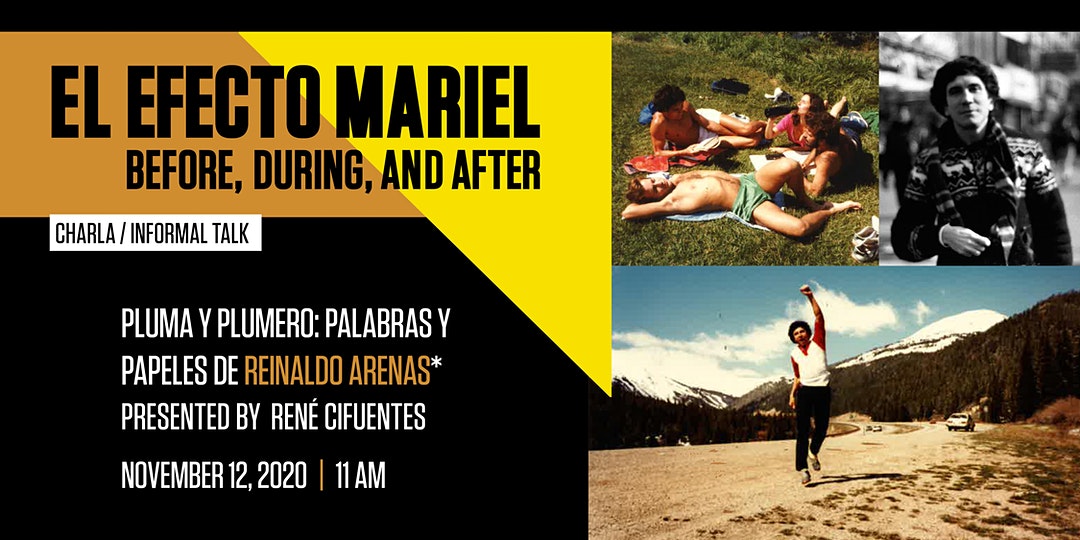
CHARLA: PLUMA Y PLUMERO: PALABRAS Y PAPELES DE REINALDO ARENAS - November 12, 2020.
Co-hosted by Harvard University’s Cuba Studies Program.
Desde su llegada a Nueva York como refugiados en 1980, Reinaldo Arenas y René Cifuentes formaron una íntima y jocosa amistad que duraría hasta los últimos años del escritor, con el cual colaboraría en diferentes proyectos, incluyendo la fundación de la revista Mariel. En su charla, Cifuentes intenta explicar esta amistad, plenamente documentada con fotos, grabaciones de llamadas telefónicas, notas y postales, ahora depositadas en la Cuban Heritage Collection (Colección de la Herencia Cubana), para conmemorar el 40 aniversario del éxodo de Mariel y los 30 años de la desaparición de Reinaldo Arenas.
Upon their arrival as refugees in New York in 1980, Reinaldo Arenas and René Cifuentes formed an intimate and playful friendship that would last through the writer’s final years. During that time, the two collaborated on multiple projects, including founding Mariel magazine. In his talk, Cifuentes attempts to explain this friendship, which is expansively documented with photos, telephone recordings, notes, and postcards, now in the Cuban Heritage Collection, in commemoration of the 40th anniversary of the Mariel exodus and the 30 years since the loss of Reinaldo Arenas.
Sobre el Presentador
René Cifuentes nació en Camagüey en 1953 y se trasladó a La Habana en 1971 para estudiar en la Escuela Nacional de Instructores de Arte. Mientras estudiaba en dicha escuela, intentó abandonar el país clandestinamente y fue condenado a tres años en cárcel. Exiliado en Nueva York en 1980, fue uno de los fundadores de la revista Mariel, y sus artículos y ficciones aparecieron en esa publicación y en varias otras en los Estados Unidos y América Latina. Está retirado después de trabajar 18 años en el Museo de Arte Moderno (MoMA), donde ahora ejerce como voluntario.
About the Speaker
René Cifuentes was born in Camagüey in 1953 and moved to Havana in 1971 to study at the National School for Art Instructors. While studying there, he attempted to leave the country illegally and was sentenced to three years in prison. Exiled to New York in 1980, he was one of the founders of Mariel magazine. His essays and short stories appeared there and in various magazines in the United States and Latin America. He is retired, after having worked for 18 years at the Museum of Modern Art, where he now serves as a volunteer.
WEBINAR: ANTECEDENTS TO THE MARIEL BOATLIFT IN CUBA AND CUBAN-AMERICA - July 9, 2020

ANTECEDENTS TO THE MARIEL BOATLIFT IN CUBA AND CUBAN-AMERICA
JULY 9, 2020, 11 A.M. EST
WATCH RECORDING HERE
Panelists
Maria A. Cabrera Arus, Ph.D., Adjunct Professor, New York University
Michael Bustamante, Ph.D., Assistant Professor of History at Florida International University
Jeanine Navarrete, Ph.D., Independent Scholar
Mirta Ojito, Journalist and Author
María de los Angeles Torres, Ph.D., Professor of Latin American and Latino Studies, University of Illinois Chicago, (Moderator)
The first in a series of webinars and virtual programs that address the antecedents, unfolding, and aftermath of the 1980 Mariel boatlift, upon its 40th anniversary. By bringing together multiple, interdisciplinary perspectives on this historic event, the series aims to frame Mariel not in the past, but in the present, underscoring its enduring relevance and legacies.
WEBINAR: THE BOATLIFT UNFOLDS: PERSPECTIVES FROM BOTH SIDES OF THE FLORIDA STRAITS - August 13, 2020

THE BOATLIFT UNFOLDS: PERSPECTIVES FROM BOTH SIDES OF THE FLORIDA STRAITS
August 13, 2020, 11 A.M. EST
WATCH RECORDING HERE
Co-hosted by Harvard University’s Cuba Studies Program.
Co-sponsored by HistoryMiami Museum.
Panelists
Ambassador Ernesto Pinto Bazurco Rittler
Writer, lawyer in International Politics, and former Head of the Diplomatic Mission at the Peruvian Embassy in Cuba
Abel Sierra Madero, Ph.D., Independent Scholar
Omar Granados, Ph.D., Assistant Professor of Global Cultures & Languages, University of Wisconsin-La Crosse
Neri Torres, MFA, Visiting Professor, The University of Texas at El Paso, and Artistic Director of Miami-based IFE-ILE Afro-Cuban Dance Company
Michael Bustamante, Ph.D. Assistant Professor of History at Florida International University (Moderator)
The Boatlift Unfolds: Perspectives from Both Sides of the Florida Straits, the second in our series of webinars and virtual programs addressing the antecedents, unfolding, and aftermath of the 1980 Mariel boatlift. In this event, panelists will offer unique perspectives on the unfolding of the Mariel crisis itself—from its beginnings at the Peruvian embassy in Havana, to the arrival and detention of many Mariel migrants on far-flung military bases across the United States. We will also hear detailed accounts of the mass rallies and “acts of repudiation” carried out in Cuba to denounce those choosing to depart, and we will explore how race and racism fed into these practices of internal stigmatization. Ironically, the denigration of Mariel migrants in Cuba would mirror the ways some would see and treat them in the United States.
THE EXILE COMMUNITY RESPONDS: SOLIDARITY AND STIGMATIZATION - September 12, 2020
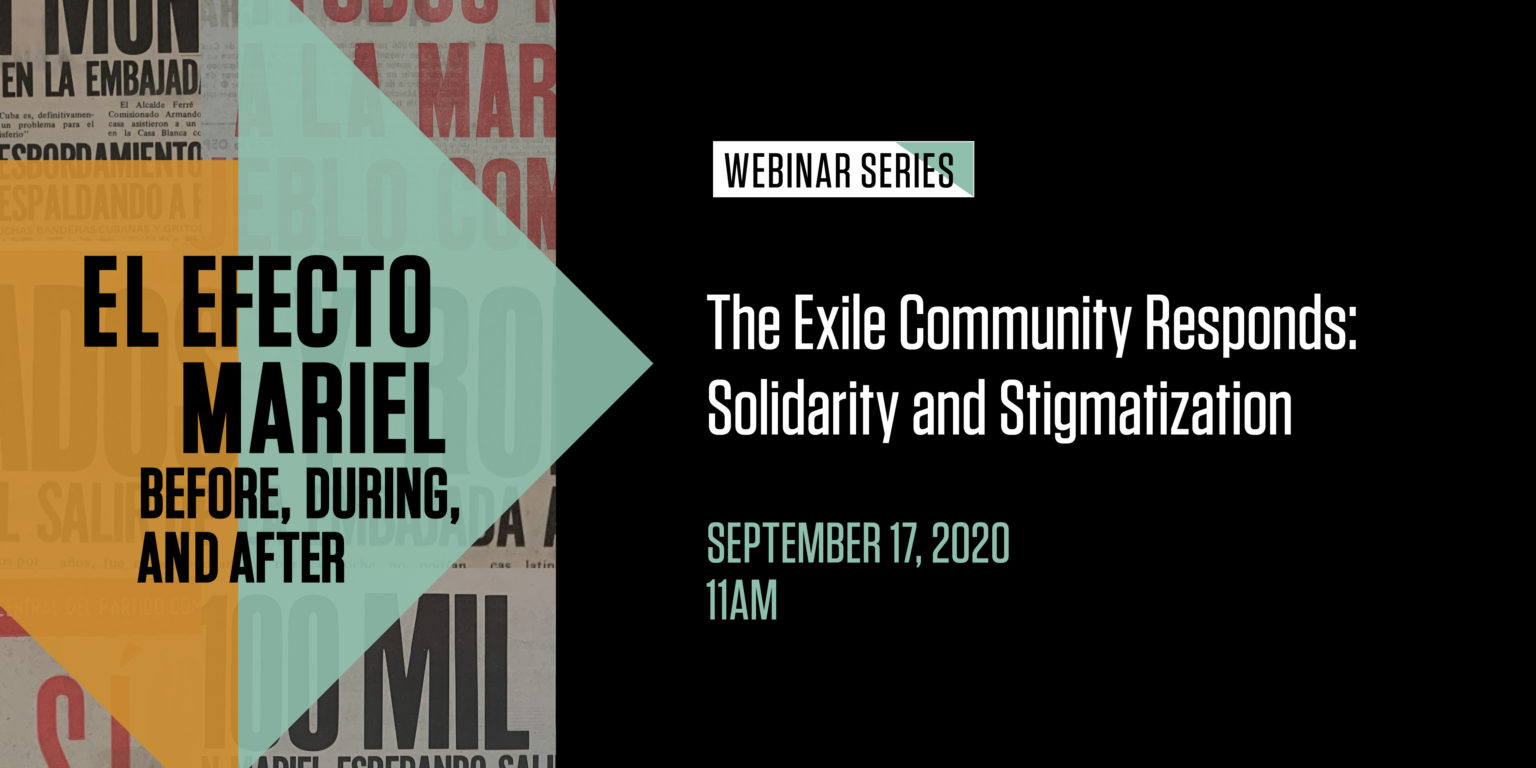
THE EXILE COMMUNITY RESPONDS: SOLIDARITY AND STIGMATIZATION
September 12, 2020. 11 A.M. EST
WATCH THE RECORDING HERE
Panelists
Siro del Castillo
Human Rights Advocate and Community Leader on Immigrant Issues
Danielle Clealand, Ph.D., Associate Professor, Department of Mexican American and Latino Studies, University of Texas at Austin
Monika Gosin, Ph.D., Associate Professor, Department of Sociology, College of William and Mary
Aida Levitan, Ph.D., President, The Levitan Group and President, ArtesMiami
Fabiola Santiago, Author and Columnist at The Miami Herald (Moderator)
By 1980, Miami’s Cuban community, made up of refugees and exiles who arrived in South Florida in the 1960s and early 1970s, had begun to garner significant economic and political power locally. These early Cuban immigrants—many of whom are informally known today as el exilio histórico, or the historic exile community—were in many ways a monolithic group, i.e. mostly white, Catholic, socially and politically conservative, and hailing from the island’s pre-revolutionary professional and middle classes. That demographic and cultural picture changed considerably when beginning in April of 1980, and over the span of only a few months, more than 125,000 new refugees arrived on the shores of South Florida after fleeing the island via the Port of Mariel.
How did the established Cuban community in Miami respond to this new influx of Cuban refugees who were more racially and culturally diverse, and whose experiences on the island were in many ways quite different? This panel explores how the newly arrived Cubans (Marielitos) were greeted with an outpouring of support, on the one hand, and increasingly with deep suspicions (especially along lines of class and race), on the other. Panelists will further explore how Mariel migrants settling in Miami added new complications to the city’s already fraught inter- and intra-ethnic dynamics. For that reason, the story of their early reception in the United States, like the story of their migration as a whole, is arguably one that resists easy moral lessons.
WEBINAR: THE MARIEL EFFECT: SOCIAL AND RACIAL TENSIONS IN SOUTH FLORIDA IN THE WAKE OF THE BOATLIFT

THE MARIEL EFFECT: SOCIAL AND RACIAL TENSIONS IN SOUTH FLORIDA IN THE WAKE OF THE BOATLIFT
October 15, 2020, 11 A.M. EST
Watch Recording Here
Panelists
The arrival of 125,000 Cubans from the Port of Mariel to South Florida beginning in April 1980 coincided with a particularly volatile period in Miami. The killing of Arthur McDuffie— an unarmed Black man—by White and Latino police officers who were later acquitted, exacerbated deeply rooted tensions in race relations among African Americans, Whites, and Latinos (primarily Cubans) in Miami. At the same time, the new influx of Cuban refugees was associated with another crisis: the HIV/AIDS epidemic. Three distinct voices representing recent scholarship will address the complicated ways in which issues around race and gender played out post-Mariel during the 1980s and continue to shape Miami today.
El Efecto Mariel social media post (May 5, 2020)
 How often do you see an image of a young Afro-Cuban man sewing while being held at a detention camp in Arkansas? This portrait taken by the photographer Jim Caletta asks us to rethink what we know about the Mariel Boatlift of 1980—the mass exodus of over 125,000 Cuban refugees to the shores of South Florida in the span of only a few months. At that time, images of overcrowded boats dominated the media and reported fears of throngs of criminals arriving in the US sparked a deep resentment against this wave of Cubans who made the perilous journey. This photograph of a man who made that journey and captured here sewing while held as a refugee at Fort Chaffee helps dispel those stereotypes. Who was he and what do you read in his expression?
How often do you see an image of a young Afro-Cuban man sewing while being held at a detention camp in Arkansas? This portrait taken by the photographer Jim Caletta asks us to rethink what we know about the Mariel Boatlift of 1980—the mass exodus of over 125,000 Cuban refugees to the shores of South Florida in the span of only a few months. At that time, images of overcrowded boats dominated the media and reported fears of throngs of criminals arriving in the US sparked a deep resentment against this wave of Cubans who made the perilous journey. This photograph of a man who made that journey and captured here sewing while held as a refugee at Fort Chaffee helps dispel those stereotypes. Who was he and what do you read in his expression?
El Efecto Mariel social media post (May 13, 2020)
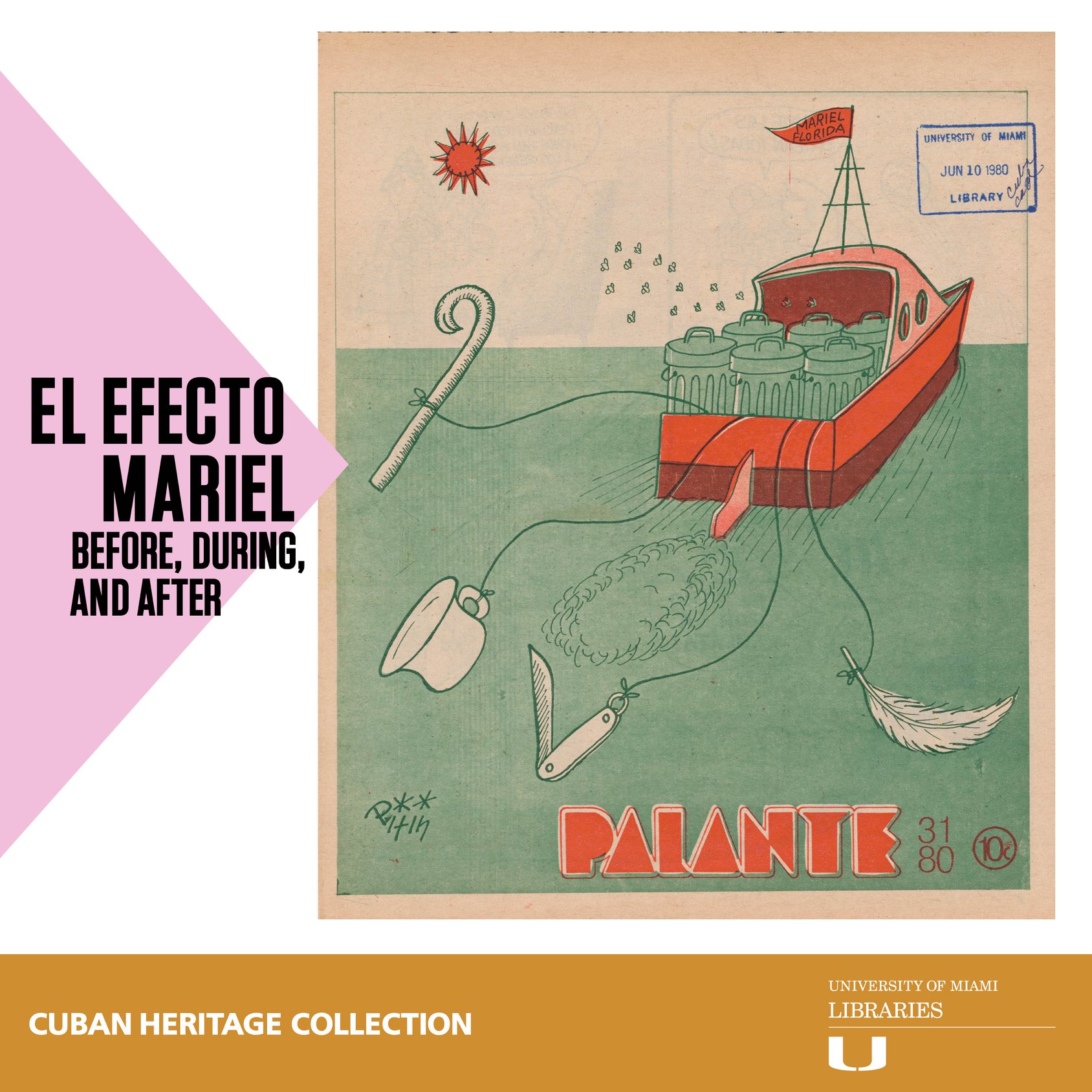 PALANTE is a Cuban periodical founded on October 16, 1961—soon after the triumph of the Cuban Revolution—and published weekly through 1994 (at which time it was then released monthly). Harnessing the power of political cartoons, Palante’s contributors relied on humor and satire as strategic tools for ideological and social critique, as well as fostering political propaganda. During the span of the 1980s, the Cuban government mounted campaigns targeting those who left the country via the Mariel Boatlift repeatedly referring to them as escoria [scum] or basura [garbage]. This cover from June 10, 1980, depicting a boat carrying garbage cans instead of refugees succinctly illustrates that message.
PALANTE is a Cuban periodical founded on October 16, 1961—soon after the triumph of the Cuban Revolution—and published weekly through 1994 (at which time it was then released monthly). Harnessing the power of political cartoons, Palante’s contributors relied on humor and satire as strategic tools for ideological and social critique, as well as fostering political propaganda. During the span of the 1980s, the Cuban government mounted campaigns targeting those who left the country via the Mariel Boatlift repeatedly referring to them as escoria [scum] or basura [garbage]. This cover from June 10, 1980, depicting a boat carrying garbage cans instead of refugees succinctly illustrates that message.El efecto Mariel social media post (May 19, 2020)
 On the steps of a row of army barracks accommodating recently arrived Mariel refugees, a Cuban woman contemplates her new reality. Following on from our inaugural post of an Afro-Cuban man sewing, these extraordinary images by Jim Caletta provide an intimate entry into the experiences of Mariel refugees temporarily held at Fort Chaffee and other military installations in the US. It is a nameless portrait that at once gives us sobering insight into the much-misunderstood Mariel migration of 1980. We chose this photograph for the questions and discussions it can provoke of this time in Cuba-US history.
On the steps of a row of army barracks accommodating recently arrived Mariel refugees, a Cuban woman contemplates her new reality. Following on from our inaugural post of an Afro-Cuban man sewing, these extraordinary images by Jim Caletta provide an intimate entry into the experiences of Mariel refugees temporarily held at Fort Chaffee and other military installations in the US. It is a nameless portrait that at once gives us sobering insight into the much-misunderstood Mariel migration of 1980. We chose this photograph for the questions and discussions it can provoke of this time in Cuba-US history.
El efecto Mariel social media post (May 23, 2020)

"If I would have learned English in Fort Chaffee, now I would not feel like a martian in this city" laments the central figure in this whimsical drawing that blends reality with fantasy (notice the antennae, bat-like wings, and web-feet!). Although the illustration is lighthearted and humorous, the sentiments expressed here address the more poignant feelings of isolation and "alienation" experienced by many immigrants when they first arrive in a foreign country. In this picture, we are privy to the thoughts of the young man-turned-Martian that point to the more complex, underlying anxieties around processes of adjustment (and assimilation?) in which language plays a central role. This work is one in a series of three original, large-format ink drawings found in our Fort Chaffee Collection and will be featured in our upcoming exhibition

El efecto Mariel social media post (August 5, 2020)
 On April 19, 1980, more than a million Cubans gathered in front of the Peruvian Embassy on Havana’s Quinta Avenida during the Marcha del Pueblo Combatiente. For over 13 hours, protestors demonstrated against the over 10,000 Cubans who had been seeking asylum in the embassy.
On April 19, 1980, more than a million Cubans gathered in front of the Peruvian Embassy on Havana’s Quinta Avenida during the Marcha del Pueblo Combatiente. For over 13 hours, protestors demonstrated against the over 10,000 Cubans who had been seeking asylum in the embassy.
El efecto Mariel social media post (August 5, 2020) continued
 The front-page headline of the following day’s Granma, Cuba’s official Communist Party newspaper, underscored the fissures that the Peruvian Embassy Crisis had exposed by claiming the million as the true “people” of Cuba. Its accompanying photo essay, subtitled “The Faces of the People,” captured a populace ignited by anti-American fervor directed at their former compatriots who in their estimation were “abandoning” the Revolution.
The front-page headline of the following day’s Granma, Cuba’s official Communist Party newspaper, underscored the fissures that the Peruvian Embassy Crisis had exposed by claiming the million as the true “people” of Cuba. Its accompanying photo essay, subtitled “The Faces of the People,” captured a populace ignited by anti-American fervor directed at their former compatriots who in their estimation were “abandoning” the Revolution.
El efecto Mariel social media post (August 5, 2020) continued
 Signs called for the "Yankees to leave the Caribbean" and for the “scum [escoria]” to leave the island, with Granma’s editors comparing the victory of the march to the country’s previous one at Playa Girón. That same day, on April 20, Fidel Castro announced the opening of the Port of Mariel to allow exiled Cubans to pick up their relatives who wanted to leave the island.
Signs called for the "Yankees to leave the Caribbean" and for the “scum [escoria]” to leave the island, with Granma’s editors comparing the victory of the march to the country’s previous one at Playa Girón. That same day, on April 20, Fidel Castro announced the opening of the Port of Mariel to allow exiled Cubans to pick up their relatives who wanted to leave the island.
